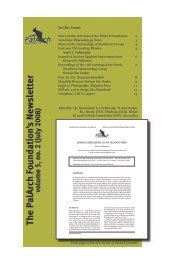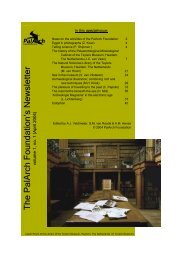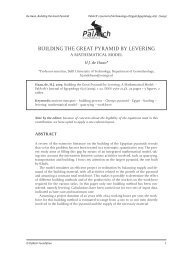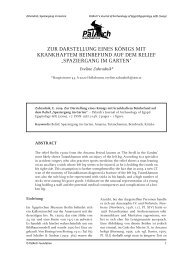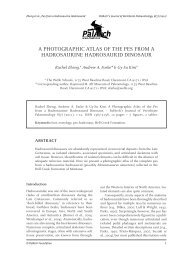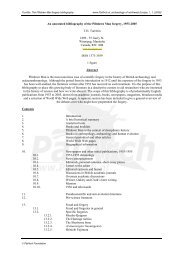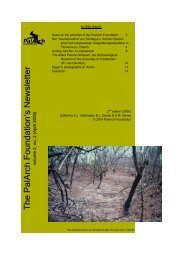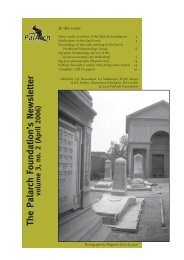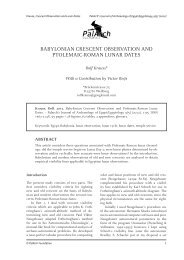neural spine bifurcation in sauropod dinosaurs of the - PalArch
neural spine bifurcation in sauropod dinosaurs of the - PalArch
neural spine bifurcation in sauropod dinosaurs of the - PalArch
Create successful ePaper yourself
Turn your PDF publications into a flip-book with our unique Google optimized e-Paper software.
Wedel & Taylor, Neural Sp<strong>in</strong>e Bifurcation <strong>in</strong> Sauropods <strong>PalArch</strong>’s Journal <strong>of</strong> Vertebrate Palaeontology, 10(1) (2013)<br />
Figure 19. The sixth cervical vertebrae <strong>of</strong> Diplodocus carnegii CM 84/94, Suuwassea emilieae ANS 21122, and Apatosaurus<br />
sp. CM 555 <strong>in</strong> left lateral view, scaled to <strong>the</strong> same centrum length. Actual centrum lengths are 442 mm, 258 mm, and 327<br />
mm, respectively. Diplodocus carnegii modified from Hatcher (1901: plate 3), reversed left to right for ease <strong>of</strong> comparison.<br />
Suuwassea emilieae from a photo provided by Jerry Harris; <strong>the</strong> same photo also appears as Harris (2006c: text-figure 7B).<br />
Apatosaurus photographs by Ma<strong>the</strong>w Wedel, digitally composited by Michael Taylor.<br />
tosaurus cervicals also have tall, narrow <strong>neural</strong><br />
<strong>sp<strong>in</strong>e</strong> tips that somewhat resemble those <strong>of</strong><br />
Suuwassea.<br />
Summary – The cervical vertebrae <strong>of</strong> Suuwassea<br />
differ from those <strong>of</strong> Diplodocus <strong>in</strong> almost<br />
every detail, and <strong>the</strong>re is no evidence from<br />
presacral morphology that Suuwassea is a juvenile<br />
<strong>of</strong> Diplodocus.<br />
Apatosaurus – Accord<strong>in</strong>g to Gilmore (1936:<br />
196), C6 <strong>of</strong> A. louisae CM 3018 has a centrum<br />
length <strong>of</strong> 440 mm and a cotyle diameter <strong>of</strong> 150<br />
mm, and <strong>the</strong>refore an EI <strong>of</strong> 2.9. C6 <strong>of</strong> A. parvus<br />
UWGM 15556 was not preserved, but C5 and<br />
C7 have EIs <strong>of</strong> 2.6 and 2.4, respectively (Gilmore,<br />
1936: 196). The vertebrae between <strong>the</strong> fifth<br />
and seventh positions <strong>in</strong> Apatosaurus are <strong>the</strong>refore<br />
consistently shorter than C6 <strong>in</strong> Suuwassea<br />
(EI <strong>of</strong> 3.4), but more similar <strong>in</strong> proportions<br />
than <strong>the</strong> equivalent vertebrae <strong>in</strong> Diplodocus. As<br />
noted above, some cervical vertebrae <strong>of</strong> Apatosaurus<br />
have prezygapophyseal rami shaped<br />
like anterodorsally-project<strong>in</strong>g pedestals, and<br />
forward-lean<strong>in</strong>g, chimney-shaped <strong>neural</strong> <strong>sp<strong>in</strong>e</strong><br />
tips (Gilmore, 1936: plates 24 and 31), but <strong>in</strong> no<br />
known vertebrae <strong>of</strong> Apatosaurus do <strong>the</strong>se characters<br />
reach <strong>the</strong> same degree <strong>of</strong> expression as<br />
<strong>in</strong> Suuwassea. Note that Lovelace et al. (2008)<br />
recovered Suuwassea as an apatosaur<strong>in</strong>e, but<br />
not as Apatosaurus. The most strik<strong>in</strong>g difference<br />
between Suuwassea and Apatosaurus is<br />
that Suuwassea lacks <strong>the</strong> immense, low-hang<strong>in</strong>g<br />
cervical ribs that are diagnostic for Apatosaurus<br />
(see Upchurch et al., 2005: 80-81). The<br />
cervical ribs <strong>of</strong> Suuwassea are short, as <strong>in</strong> o<strong>the</strong>r<br />
diplodocoids, and do not extend past <strong>the</strong> end<br />
<strong>of</strong> <strong>the</strong> centrum <strong>of</strong> <strong>the</strong> vertebra on which <strong>the</strong>y<br />
orig<strong>in</strong>ate, but <strong>the</strong>y are nei<strong>the</strong>r enlarged nor set<br />
well below <strong>the</strong> centrum as <strong>in</strong> Apatosaurus. This<br />
cannot be expla<strong>in</strong>ed as an result <strong>of</strong> ontogeny<br />
because vertebrae <strong>of</strong> subadult Apatosaurus with<br />
unfused <strong>neural</strong> arches and cervical ribs never<strong>the</strong>less<br />
have greatly enlarged parapophyses to<br />
support <strong>the</strong> latter (figure 18).<br />
Summary – The cervical vertebrae <strong>of</strong> Suuwassea<br />
are more similar to those <strong>of</strong> Apatosaurus<br />
than those <strong>of</strong> Diplodocus, but <strong>the</strong>y differ<br />
<strong>in</strong> several important characters that cannot be<br />
<strong>in</strong>terpreted as ontogenetically labile. On gross<br />
morphology alone, it is very unlikely that Suuwassea<br />
represents a juvenile <strong>of</strong> ei<strong>the</strong>r taxon.<br />
The case for synonymy grows even worse when<br />
skeletochronology is considered, as discussed <strong>in</strong><br />
<strong>the</strong> next section.<br />
Ontogenetic status <strong>of</strong> Suuwassea – The Suuwassea<br />
holotype ANS 21122 can be assessed for<br />
four <strong>of</strong> <strong>the</strong> non-histological criteria <strong>of</strong> skeletal<br />
maturity discussed above:<br />
1) Sheer size;<br />
2) Fusion <strong>of</strong> <strong>the</strong> <strong>neural</strong> arches and centra;<br />
3) Fusion <strong>of</strong> <strong>the</strong> cervical ribs to <strong>the</strong>ir respective<br />
vertebrae;<br />
4) Fusion <strong>of</strong> <strong>the</strong> scapula and coracoid.<br />
We will ignore sheer size for reasons expla<strong>in</strong>ed<br />
above, and discuss <strong>the</strong> o<strong>the</strong>r evidence <strong>in</strong> turn.<br />
The <strong>neural</strong> arches are fused <strong>in</strong> <strong>the</strong> cervicals<br />
and dorsals but unfused <strong>in</strong> most <strong>of</strong> <strong>the</strong> caudals.<br />
Harris (2006c: 1107): “Of all <strong>the</strong> caudal vertebrae<br />
preserved <strong>in</strong> ANS 21122, only <strong>the</strong> distal,<br />
‘whiplash’ caudals are complete. All <strong>the</strong> rema<strong>in</strong><strong>in</strong>g<br />
vertebrae consist only <strong>of</strong> vertebral bodies<br />
© <strong>PalArch</strong> Foundation 22



